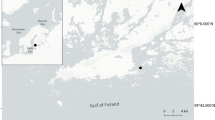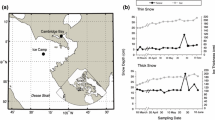Abstract
Seasonal Baltic Sea ice is structurally similar to polar sea ice and provides habitats for diverse ice organism assemblages that are integral to the biogeochemistry and ecology of the sea during winter. Temperature and inorganic nitrogen sources have been suggested to control bacterial growth, with increasing dependence on ammonium at low temperatures. To study the bacterial growth and preference for the nitrogen source, we conducted experiments at 0 and 4°C, using ammonium and nitrate as nitrogen sources at two coastal fast-ice stations in the Gulf of Finland and in the Gulf of Bothnia during three successive winters. The two study sites differ markedly in relation to the allochthonous dissolved organic matter supply from the catchment area. High levels of bacterial growth were recorded at both study sites, with community generation times of 15–37 h. The measured bacterial growth efficiencies of 20–58% suggest that the Baltic sea ice brines provide a rich medium for bacterial growth and efficient functioning of bacteria-based food webs. Our experiments with sea ice samples showed a preference for ammonium at both temperatures and high potential growth in both types of nitrogen supplies. No major differences in phosphorus depletion rates were found at the two temperatures, but rates were always highest when ammonium was added to the experiments. These experiments point out that ice maturity, presumably through changes in bacterial community structure, impacts nitrogen processes and that these processes are pronounced prior to melting of the ice.


Similar content being viewed by others
References
Apple JK, del Giorgio PA (2007) Organic substrate quality as the link between bacterioplankton carbon demand and growth efficiency in a temperate salt-marsh estuary. ISME J 1:729–742
Bano N, Hollinbaugh JT (2000) Diversity and distribution of DNA sequences with affinity to ammonia-oxidizing bacteria of the β subdivision of the class Proteobacteria in the Arctic Ocean. Appl Environ Microbiol 66:1960–1969
Collins RE, Rocap G, Deming JW (2010) Persistence of bacterial and archaeal communities in sea ice through an Arctic winter. Environ Microbiol 12:1828–1841
del Giorgio PA, Cole JJ (1998) Bacterial growth efficiency in natural aquatic systems. Annu Rev Ecol Syst 29:503–541
Dieckmann GS, Lange MA, Ackely SF, Jennings JC (1991) The nutrient status in sea ice of the Weddell Sea during winter: effects of ice texture and algae. Polar Biol 11:449–456
Fuhrman JA, Azam F (1980) Bacterioplankton secondary production estimates for coastal waters of British Columbia, Antarctica, and California. Appl Environ Microbiol 39:1085–1095
Fuhrman JA, Azam F (1982) Thymidine incorporation as a measure of heterotrophic bacterioplankton production in marine surface waters: Evaluation and field results. Mar Biol 66:109–120
Golden KM, Ackley SF, Lytle VI (1998) The percolation phase transition in sea ice. Science 282:2238–2241
Gradinger R, Spindler M, Weissenberger J (1992) On the structure and development of Arctic pack ice communities in Fram Strait: a multivariate approach. Polar Biol 12:727–733
Granskog MA, Kaartokallio H (2004) An estimation of the potential fluxes of nitrogen, phosphorus, cadmium and lead from sea ice and snow in the northern Baltic Sea. Water Air Soil Poll 154:331–347
Granskog MA, Kaartokallio H, Kuosa H, Thomas DN, Ehn J, Sonninen E (2005) Scales of horizontal patchiness in chlorophyll a, chemical and physical properties of landfast sea ice in the Gulf of Finland (Baltic Sea). Polar Biol 28:276–283
Granskog MA, Kaartokallio H, Kuosa H, Thomas DN, Vainio J (2006) Sea ice in the Baltic Sea—a review. Est Coast Shelf Sci 70:145–160
Grasshoff K, Ehrhardt M, Kremling K (1983) Methods of seawater analysis, 2nd edn. Verlag Chemie, Weinheim
Grossmann S (1994) Bacterial activity in sea ice and open water of the Weddell Sea, Antarctica: a microautoradiographic study. Microb Ecol 28:1–8
Grossmann S, Dieckmann G (1994) Bacterial standing stock, activity and carbon production during formation and growth of sea ice in the Weddell Sea, Antarctica. Appl Environ Microbiol 60:2746–2753
Gundersen K, Heldal M, Norland S, Purdie DA, Knap A (2002) Elemental C, N, and P cell content of individual bacteria collected at the Bermuda Atlantic Time-series Study (BATS) site. Limnol Oceanogr 47:1525–1530
Haecky P, Andersson A (1999) Primary and bacterial production in sea ice in the northern Baltic Sea. Aquat Microb Ecol 20:107–118
Hagström Å, Azam F, Kuparinen J, Zweifel U-L (2001) Pelagic plankton growth and resource limitations in the Baltic Sea. In: Wulff FV, Rahm LA, Larsson P (eds) A systems analysis of the Baltic Sea. Springer, Berlin
Helmke E, Weyland H (1995) Bacteria in sea ice and underlying water of the eastern Weddell Sea in midwinter. Mar Ecol Prog Ser 117:269–287
Hietanen S, Kuparinen J, Oja RJ, Tuominen L (2001) Different filtration treatments and centrifugation in measuring bacterial production in brackish waters. Boreal Environ Res 6:221–229
Hobbie JE, Daley RJ, Jasper S (1977) Use of Nuclepore filters for counting bacteria by fluorescence microscopy. Appl Environ Microbiol 33:1225–1228
Houghton JT, Ding Y, Griggs DJ, Noguer M, van der Linden PJ, Dai X, Maskell J, Johnson CA (2001) Climate change 2001: the scientific basis. Contribution of Working Group I to the Third Assessment Report of the Intergovernmental Panel on Climate Change. Cambridge University Press, United Kingdom
Jones RD, Morita RY (1985) Low-temperature growth and whole-cell kinetics of a marine ammonium oxidizer. Mar Ecol Prog Ser 21:239–243
Kaartokallio H (2001) Evidence for active microbial nitrogen transformations in sea ice (Gulf of Bothnia, Baltic Sea) in midwinter. Polar Biol 24:21–28
Kaartokallio H (2004) Food web components, and physical and chemical properties of Baltic Sea ice. Mar Ecol Prog Ser 273:49–63
Kaartokallio H, Laamanen M, Sivonen K (2005) Responses of Baltic Sea ice and open water communities to salinity change. Appl Environ Microbiol 71:4364–4371
Kaartokallio H, Kuosa H, Thomas DN, Granskog MA, Kivi K (2006) Biomass, composition and activity of organism assemblages along a salinity gradient in sea ice subjected to river discharge in the Baltic Sea. Polar Biol 30:183–197
Kaartokallio H, Tuomainen J, Kuosa H, Kuparinen J, Martikainen PJ, Servomaa K (2008) Succession of natural sea-ice bacterial communities in the Baltic Sea fast ice. Polar Biol 31:783–793
Kawamura T, Shirasawa K, Ishikawa N, Lindfors A, Rasmus K, Granskog MA, Leppäranta M, Martma T, Vaikmäe R (2001) Time series observations of the structure and properties of brackish ice in the Gulf of Finland, the Baltic Sea. AnnGlaciol 33:1–4
Kirchman D, K’Nees E, Hodson R (1985) Leucine incorporation and its potential as a measure of protein synthesis by bacteria in natural aquatic systems. Appl Environ Microbiol 49:599–607
Kirchman DL, Hill V, Cottrell MT, Gradinger R, Malmstrom RR, Parker A (2009) Standing stocks, production, and respiration of phytoplankton and heterotrophic bacteria in the western Arctic Ocean. Deep-Sea Res II 56:1237–1248
Kuosa H, Kaartokallio H (2006) Experimental evidence on nutrient and substrate limitation of Baltic Sea ice algae and bacteria. Hydrobiologia 554:1–10
Kuparinen J (1988) Development of bacterioplankton during winter and early spring at the entrance to the Gulf of Finland, Baltic Sea. Verh Internat Verein Limnol 23:1869–1878
Kuparinen J, Kuosa H (1993) Autotrophic and heterotrophic picoplankton in the Baltic Sea. Adv in Mar Biol 29:73–128
Kuparinen J, Kuosa H, Andersson A, Autio R, Granskog MA, Ikävalko J, Kaartokallio H, Karell K, Leskinen E, Piiparinen J, Rintala J-M, Tuomainen J (2007) Role of Baltic Sea sea-ice biota in nutrient and organic material cycles. Ambio 36:149–154
Langenheder S, Kisand V, Lindström ES, Wikner J, Tranvik LJ (2004) Growth dynamics within bacterial communities in riverine and estuarine batch cultures. Aquat Microb Ecol 37:137–148
Lee S, Fuhrman JA (1987) Relationships between biovolume and biomass of naturally derived marine bacterioplankton. Appl Environ Microbiol 53:1298–1303
Lee S, Kang Y-C, Fuhrman JA (1995) Imperfect retention of natural bacterioplankton cells by glass fibre filters. Mar Ecol Prog Ser 119:285–290
Maranger R, Bird DF, Junipers K (1994) Viral and bacterial dynamics in Arctic sea ice during the spring algal bloom. Mar Ecol Prog Ser 111:121–127
Meier HE (2002) Regional ocean climate simulations with a 3D ice-ocean model for the Baltic Sea. Part 2: results for sea ice. Clim Dynam 19:255–266
Mock T, Meiners KM, Giesenhagen HC (1997) Bacteria in sea ice and underlying brackish water at 54 W260 5000 N (Baltic Sea, Kiel Bight). Mar Ecol Prog Ser 158:23–40
Nayar S, Chou LM (2003) On the relative efficiency of different filters for phytoplankton productivity studies. Estuar Coast Shelf Sci 58:241–248
Pomeroy LR, Wiebe WJ (2001) Temperature and substrates as interactive limiting factors for marine heterotrophic bacteria. Aquat Microb Ecol 23:187–204
Priscu JC, Downes MT, Priscu LR, Palmisano AC, Sullivan CW (1990) Dynamics of ammonium oxidizer activity and nitrous oxide (N2O) within and beneath Antarctic sea ice. Mar Ecol Prog Ser 62:37–46
Reay DS, Nedwell DB, Priddle J, Ellis-Evans JC (1999) Temperature dependence of inorganic nitrogen uptake: reduced affinity for nitrate at suboptimal temperatures in both algae and bacteria. Appl Environ Microbiol 65:2577–2584
Riemann B, Bjørnsen PK, Newell S, Fallon R (1987) Calculation of cell production of coastal marine bacteria based on measured incorporation of [3H]thymidine. Limnol Oceanogr 32:471–476
Rivkin RB, Legendre L (2001) Biogenic carbon cycling in the upper ocean: effects of microbial respiration. Science 291:2398–2400
Rivkin RB, Putt M, Alexander SP, Meritt D, Gaudet L (1989) Biomass and production in polar planktonic and sea ice microbial communities: a comparative study. Mar Biol 101:273–283
Robinson C (2008) Heterotrophic bacterial respiration. In: Kirchman DL (ed) Microbial ecology of the oceans, 2nd edn. Wiley, New Jersey, pp 299–334
Rysgaard S, Glud RN, Sejr MK, Blicher ME, Stahl HJ (2008) Denitrification activity and oxygen dynamics in Arctic sea ice. Polar Biol 31:527–537
Salonen K (1979) A versatile method for the rapid and accurate determination of carbon by high temperature combustion. Limnol Oceanogr 24:177–183
Seinä A, Palosuo E (1996) The classification of the maximum annual extent of ice cover in the Baltic Sea 1720–1995. Meri 27:79–91
Sime-Ngando T, Demers S, Juniper KS (1999) Protozoan bacterivory in the ice and the water column of a cold temperate lagoon. Microb Ecol 37:95–106
Simon M, Azam F (1989) Protein content and protein synthesis rates of planktonic marine bacteria. Mar Ecol Prog Ser 51:201–213
Stedmon CA, Thomas DN, Granskog M, Kaartokallio H, Papadimitriou S, Kuosa H (2007) The characteristics of dissolved organic matter in Baltic coastal sea ice: allochthonous or autochthonous origins? Environ Sci Technol 41:7273–7279. doi:10.1021/es071210f
Steffens M, Granskog MA, Kaartokallio H, Kuosa H, Luodekari K, Papadimitriou S, Thomas DN (2006) Spatial variation of biogeochemical properties of landfast sea ice in the Gulf of Bothnia (Baltic Sea). Ann Glaciol 44:80–87
Stoecker D, Buck KR, Putt M (1993) Changes in the sea-ice brine community during the spring-summer transition, McMurdo Sound, Antarctica. II Phagotrophic protists. Mar Ecol Prog Ser 95:103–113
Thomas DN, Lara RJ, Eicken H, Kattner G, Skoog A (1995) Dissolved organic matter in Arctic multi-year sea ice during winter: major components and relationship to ice characteristics. Polar Biol 15:477–483
Wells LE, Deming JW (2006) Characterization of a cold-active bacteriophage on two psychrophilic marine hosts. Aquat Microb Ecol 45:15–29
Acknowledgments
We are grateful to the Tvärminne Zoological Station, Umeå Marine Science Centre and Finnish Institute of Marine Research for research facilities, equipment and help with the nutrient analysis and to the ICEMAT research group for support and help during the studies. We want to give special thanks to the Walter and Andrée de Nottbeck Foundation for the long-term funding of sea ice researchers and for the support of our collaborators in making their participation in our field campaigns possible. We also want to thank the reviewers for valuable comments and Dr. James Thompson for correcting the language. This study was funded by the University of Helsinki (J. Kuparinen), Finnish Institute of Marine Research (R. Autio) and the Academy of Finland BIREME programme (H. Kaartokallio).
Author information
Authors and Affiliations
Corresponding author
Rights and permissions
About this article
Cite this article
Kuparinen, J., Autio, R. & Kaartokallio, H. Sea ice bacterial growth rate, growth efficiency and preference for inorganic nitrogen sources in the Baltic Sea. Polar Biol 34, 1361–1373 (2011). https://doi.org/10.1007/s00300-011-0989-y
Received:
Accepted:
Published:
Issue Date:
DOI: https://doi.org/10.1007/s00300-011-0989-y




